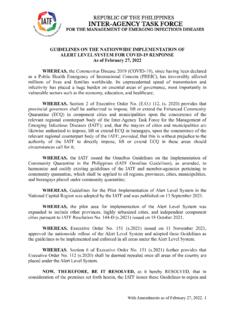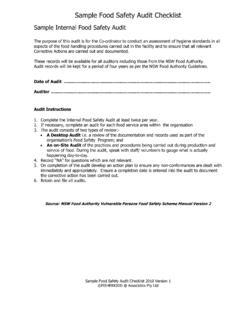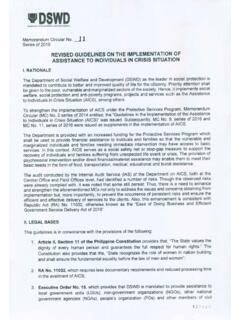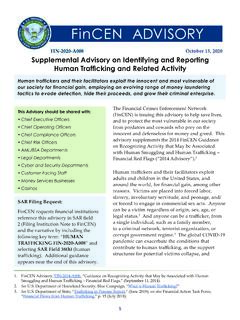Transcription of TECHNIQUES AND GUIDELINES FOR SOCIAL WORK …
1 Bradford W. Sheafor, Colorado State UniversityCharles Horejsi, The University of MontanaAllyn & Bacon75 Arlington St., Suite 300 Boston, MA 2006chapter 5 The pages of this Sample Chapter may haveslight variations in final published contact your local Allyn & Bacon/Longman AND GUIDELINES FORSOCIAL WORK PRACTICE, 7/EThe colors in this document are not an accurate representation of the final textbook VSpecialized Techniquesand GUIDELINES for SOCIAL Work PracticeMost of the TECHNIQUES and GUIDELINES described in prior sections of this bookcould be used by almost any SOCIAL worker, in almost any SOCIAL work position.
2 In almost any human services agency. In addition to the generic tools of the SOCIAL worker s trade, specialized knowledge and skills are required for somesocial work practice activities. Part V concludes the book with two chapters onthese specialized aspects of SOCIAL client groups require special sensitivity by the SOCIAL worker. For example, unique insight and understanding is required to help a client dealwith the devastating impact of poverty, to serve a client who has been batteredby a spouse, or to carefully assist a client who is at risk of committing from different age groups call for special sensitivity, too.
3 Working with achild or adolescent requires knowledge of developmental factors and commu-nication skills that are unique to young people, and at the other end of the agespectrum, older people also have unique needs that a SOCIAL worker should rec-ognize. These and other client conditions ( , cognitive delay, brain injury,physical disability, chemical dependence, serious mental illness, eating disor-ders) are often encountered in SOCIAL work practice. Chapter 15 identifies guide-lines for working with clients experiencing these circumstances and set of specialized GUIDELINES can help the SOCIAL worker obtainemployment and have a satisfying and productive experience as a socialworker.
4 Chapter 16 presents GUIDELINES that will assist the worker in dealingwith the demands of a SOCIAL work job. Items about managing stress, prevent-ing worker burnout, working within and coping with life in a bureaucracy, andgiving and using supervision can improve a worker s effectiveness and effi-ciency. In addition, there are GUIDELINES for performing the challenging tasks oftestifying in court and dealing with managed care. And given the times inwhich we live, items on dealing with sexual misconduct and avoiding malprac-tice suits have been included, as well.
5 Finally, to support the SOCIAL worker incarrying out his or her professional obligations, this chapter provides guide-lines for consuming and contributing to SOCIAL work knowledge, improving thesocial work image, and becoming a leader in the human for Workingwith Vulnerable Client GroupsINTRODUCTIONS ocial workers practice within a wide variety of settings, and consequently, they encounter a wide variety of clients with a wide variety of concerns, problems, andrequests. Although it is not uncommon to find that many of the clients served by aparticular agency or program have the same presenting problem, each client is anindividual and will react to his or her situation and to the SOCIAL worker in a uniqueway.
6 Thus, SOCIAL workers must always adapt their approaches and TECHNIQUES tothe special needs, characteristics, and circumstances of the clients they this chapter, items were selected to illustrate how a SOCIAL worker mightadapt his or her approach to the client by providing information on several differentclient groups and offering GUIDELINES for addressing the special needs, characteris-tics, and challenges presented by each group. By comparing the approaches recom-mended for these diverse client groups, the reader will come to a deeper apprecia-tion of why direct-service practitioners, as well as those who design and administerprograms, must always consider the uniqueness of the clients they serve.
7 In addi-tion, the reader will understand more clearly why an approach that works well forone group may not be appropriate for Client Who Is PoorPURPOSE:To adapt direct-service approaches to the concerns of persons living in :As a profession, SOCIAL work has always focused attention on poverty and the difficul-ties faced by persons who do not have enough resources to obtain the basics of life,such as food , shelter, and medical and dental care. Poverty has devastating effectson individuals, families, and communities.
8 It is a contributing factor to many otherproblems, such as the breakup of families, violence, crime, substance abuse, suicide,and a multitude of health problems. Poverty is especially injurious to children be-cause they are most vulnerable to the effects of poor nutrition, disease, family inse-curity, and SOCIAL causes of poverty are always complex and will vary somewhat, dependingon whether one is examining poverty in a first-world, modern country or in a , developing country. Among the economic forces that contribute to poverty ina developed country such as the United States are recession, downturns in regionaleconomies, widespread job layoffs, shifts in the types of skills needed to secure a job,and rapid increases in the costs of essential goods and services ( , housing, elec-tricity, health care).
9 Racism and job discrimination can also restrict the economicopportunities available to whole segments of a population. And in some instances,poverty results from the SOCIAL dislocation and economic disruption caused by waror political turmoil. Natural disasters, such as floods and earthquakes, can have sim-ilar SOCIAL and economic in good economic times, some individuals and groups are at risk of beingpoor, including those with inadequate education and few job skills and those whohave significant intellectual limitations, a serious mental illness, an addiction, or adebilitating health problem.
10 Moreover, individuals and families who are economi-cally independent can quickly slide into poverty after a tragedy such as a house fire,a serious injury or illness, or the death of the family s breadwinner. People who areelderly and live on a fixed income are also at risk of slipping into poverty wheneverthere are significant increases in the cost of living. In the United States, many of those who are poor are the so-called are holding down two or three part-time jobs but not earning an ade-quate income or receiving important benefits such as health insurance.















